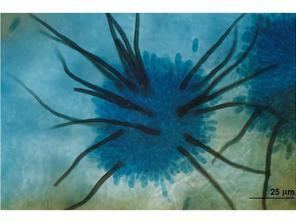Family Glomerellaceae | Subphylum Pezizomycotina Genus Colletotrichum Rank Species | |
 | ||
Similar Colletotrichum, Glomerella cingulata, Hemileia vastatrix, Colletotrichum acutatum, Colletotrichum musae | ||
Colletotrichum kahawae top 5 facts
Colletotrichum kahawae is a fungal plant pathogen that causes Coffee Berry Disease (CBD) on Arabic coffee crops. The pathogen is an ascomycete that reproduces sexually and asexually. The asexual spores (conidia) are stored within acervuli. This disease is considered to be one of the major factors hampering Arabic coffee production in the African continent, which represents current geographic range of the fungus. Coffee berry disease causes dark necrosis in spots and causes the green berries of the coffee to drop prematurely. High humidity, relatively warm temperatures, and high altitude are ideal for disease formation. Given the severity of the disease and the lack of effective control measures, there is great concern that the fungus may spread to Arabic coffee growing areas in other continents, such as South America, which could have catastrophic consequences.
Contents
- Colletotrichum kahawae top 5 facts
- Taxonomy
- Host and Symptoms
- Disease Cycle
- Origin and distribution
- Environment
- Management
- Impact
- References
Taxonomy
Until recently, the taxonomic description and position of C. kahawae was a subject of great confusion. From the range of Colletotrichum spp. that are isolated from coffee plants, four groups were initially described based on their morphological traits: CCM (C. coffeanum mycelial), CCA (C. coffeanum acervuli), CCP (C. coffeanum pink) and the Coffee berry disease (CBD) strain. The three former groups were latter recognized as C. gloeosporioides Penz (CCM and CCA) and C. acutatum Simmonds (CCP), and proved to be non-pathogenic in green coffee berries. Only the fourth group was able to infect both wounded and unwounded green berries and was formerly referred to as C. coffeanum. However, C. coffeanum was described in 1901 based on Colletotrichum isolated from coffee in Brazil, where CBD does not exist, and was probably synonymous with C. gloeosporioides, which occurs as a saprophyte or weak pathogen of ripe berries and damaged coffee tissue worldwide. Several authors attempted to emend this anomaly but it was not until 1993 that Waller and Bridge described C. kahawae as the causal agent of CBD and as a distinct species based on morphological, cultural and biochemical characters and more recently on multi-locus datasets.
Host and Symptoms
The only current host for Colletotrichum kahawae is Coffea arabica. Common symptoms are dark, necrotic, sunken spots and brown, superficial lesions. Coffee Berry Disease affects green berries and causes premature fruit drop and mummified or damaged fruits. Signs of orange-colored acervuli on the fruit, bark, and dead branches have been recorded.
Disease Cycle
Colletotrichum kahawae is an ascomycete that produces conidia from simple hyphae. The fungi can infect the plant during any stage from the flower to the berry. Mummified berries, twig bark, and dead branches are considered to be primary inoculum sources for the disease. Colletotrichum conidium germination can occur 24 hours after conidia enter into contact with the tissues of the host plant. There then follows elongation of the germ tubes, whose apical section later differentiates into an appressorium. The infection hyphae arising from those appressoria then colonize the fruit, causing necrosis of the tissues on which new acervuli form. Many berries drop prematurely, but berries that remain attached serve as a source of secondary inoculum. Most conidia are dispersed by rainfall. It is unknown what part of the pathogen survives between seasons. There is a sexual stage, but it does not play a role in the spread of CBD.
Origin and distribution
The first report of Coffee Berry Disease caused Colletotrichum kahawae dates back to 1922 in western Kenya when it led to the destruction and abandon of C. arabica plantations in some regions. Soon after, the fungus has quickly spread throughout most of the African continent, being reported in Angola (1930), Democratic Republic of the Congo (1938), Cameroon (1955), Tanzania (1964), Ethiopia (1971), Malawi and Zimbabwe (1985), and eventually most of the Arabic coffee areas in the continent were affected.
Environment
Colletotrichum kahawae has a high incidence of occurring in highland regions and there is no disease below 1000 meters above sea level. High humidity and temperatures between 20 and 22 degrees Celsius are conducive for germination and appresorium formation.
Management
Current methods for control of Coffee Berry Disease are resistance and fungicide. Resistant genes have been found in three cultivars; Rume Sudan, Hibrido de Timor, and K7. The Catimor variety has also shown resistance similar to that of Hibrido de Timor. The only one of these resistant varieties that is used commercially is Catimor. All of the other resistant varieties produce undesirable traits for commercially produced products. An issue with fungicide is that in order to be effective it requires 7-8 applications per year, which can be laborious and expensive. CBD’s chemical control may account for up to 45% of the annual cost of production. Despite such elaborate control measures, losses as high as 50% of the potential crop may still occur under unfavorable weather conditions. Colletotrichum kahawae has been shown to produce less disease when shaded by fruit trees, as the fruit trees prevent rainfall from falling on berries, thus preventing dispersal of conidia.
Impact
Because Coffee Berry Disease can become very severe and there is a lack of effective control measures, there is great concern that the fungus may spread to Arabic coffee growing areas in other continents, such as South America, which could have catastrophic consequences. Currently, however, the disease is only prevalent in areas Africa at high elevations and with high relative humidity. The disease has been recorded to cause up to 80% yield loss.
